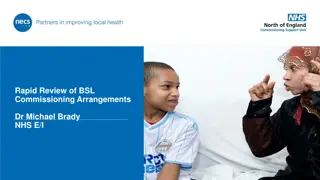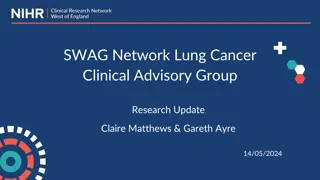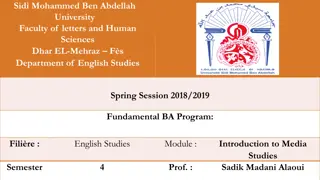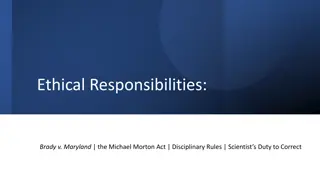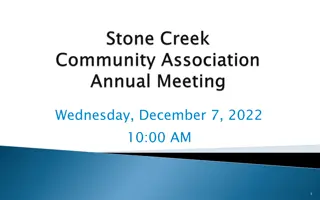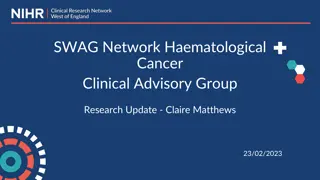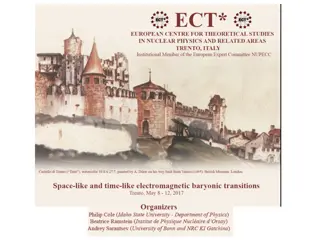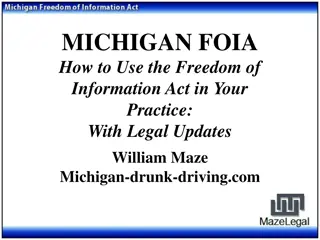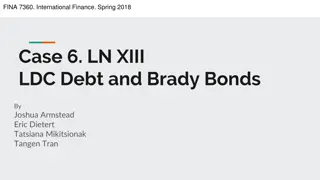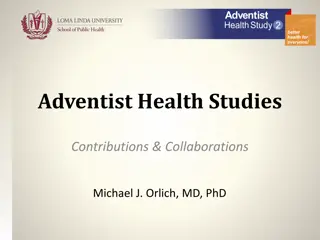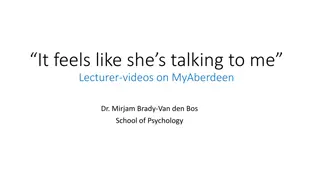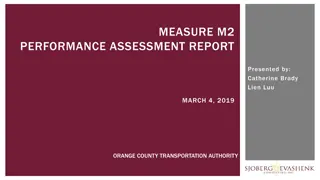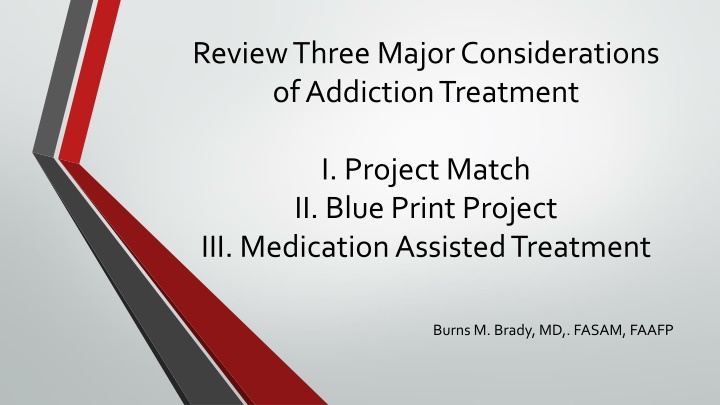
Key Considerations in Addiction Treatment: Project Match, Blueprint Project, Medication-Assisted Treatment
Explore three essential considerations in addiction treatment focusing on Project Match which studied treatment matching effectiveness, the Blueprint Project highlighting specialized care for addicted physicians, and the role of Medication-Assisted Treatment in addiction recovery.
Download Presentation

Please find below an Image/Link to download the presentation.
The content on the website is provided AS IS for your information and personal use only. It may not be sold, licensed, or shared on other websites without obtaining consent from the author. If you encounter any issues during the download, it is possible that the publisher has removed the file from their server.
You are allowed to download the files provided on this website for personal or commercial use, subject to the condition that they are used lawfully. All files are the property of their respective owners.
The content on the website is provided AS IS for your information and personal use only. It may not be sold, licensed, or shared on other websites without obtaining consent from the author.
E N D
Presentation Transcript
Review Three Major Considerations of Addiction Treatment I. Project Match II. Blue Print Project III. Medication Assisted Treatment Burns M. Brady, MD,. FASAM, FAAFP
I. Project Match A. This study was an 8 year multisite project sponsored by the National Institute on Alcohol Abuse and Alcoholism (NIAAA) at a cost of $27 million dollars. Match studied whether treatment should be uniform or assigned to patients based on specific needs and characteristics. Three types of treatment were investigated All types were administered by psychotherapists 1. Cognitive Behavioral Coping Skills Therapy focus on correcting poor self-esteem and distorted, negative, and self-defeating thinking 2. Motivational Enhancement Therapy focus on helping patients to become aware of and build on personal strengths that can help improve readiness to quit. 3. Twelve Step Facilitation focus on helping to familiarize patients with the AA philosophy and to encourage participation This study concluded that patient treatment matching is not necessary because the three techniques are equal in effectiveness
I. Project Match B. A complete review of the literature would be recommended to appreciate the furor and spectrum of responses pro and con
I. Project Match C. Journal of Studies on Alcohol and Drugs (online) January 2015 Psychiatric Severity Neither treatment was superior for patients with higher levels of psychiatric severity Patients low in psychiatric severity had more abstinent days after Twelve Step facilitation and Twelve Step participation
II. Blueprint Project How are addicted physicians treated? A national survey of Physician Health Programs Journal of Substance Abuse Treatment July 2009 A. Physicians with SUD receive care that is qualitatively different from and more effective than that offered to the general population This care is supervised/administered by PHP s. 49 states have such a program. Mission: to promote 1. early detection 2. assessment 3. evaluation 4. referral to abstinence oriented (usually) residential treatment 60-90 days duration 5. 12 Step oriented outpatient. Follow up 6. contract 5 years Recovery rate (44 programs responding) 78% for 1-2 years ---89% continuous sobriety for 5 years
I. Blueprint Project B. Follow up study Six Lessons from State PHP s to Promote Long-Term Recovery J. Psychoactive Drugs, 2012 Jan-March 1. zero tolerance for any use of alcohol and drugs 2. thorough evaluation and patient focused care 3. prolonged, frequent random testing for both alcohol and other drugs 4. effective use of leverage 5. defining and managing relapses 6. goal of lifelong recovery rooted in the 12 Step fellowship Elements of this model are in place for virtually all health care boards. Also in drug courts (family and individual) as well as pilots, attorneys, and clergy
III. Medication Assisted Treatment MAT A. Review neuropharmacology and reward center with consideration of medications recommended or used in addiction treatment
NEUROTRANSMITTORS I. Single Amino Acid Single Amino Acid Receptors AMPA KA NMDA Receptors AMPA KA NMDA Acaprosate Acaprosate 90% 90% A. A. Glutamate Glutamate B. B. GABA Alcohol BZ Sedative Hypnotic withdrawal GABA Alcohol BZ Sedative Hypnotic withdrawal GABA GABA GABAA A GABAB Gabapentin B Pregabalin Gabapentin (Neurontin) Pregabalin (Lyrica) (Neurontin) (Lyrica) II. II. Neuropeptides (Narcotics) Neuropeptides (Narcotics) Receptors MU Kappa Delta Orphan Receptors MU Kappa Delta Orphan Buprenorphine Methadone Naltrexone ( (Vivatrol Buprenorphine Methadone Naltrexone Vivatrol) ) 8% 8% A. B. C. D. A. Endorphin B. Enkeflin C. Dynorphin D. Orphanin Endorphin Beta Enkeflin Dynorphin Orphanin Beta
III. Aminergics 8% A. Dopamine (Alcohol, Cocaine, Pot, Narcotics, Nicotine) B. Serotonin (SSRI Drugs) withdrawal effect Receptors D1 D2 D3 D4 D5 Receptors 5HT3 5HT2 5HT1A C. Acetyl Choline (Nicotine, Pot) D. Noradrenaline (Alcohol, Combination SSRI) Receptor Nicotinic AC Chantix Effexor IV. Neurosteroids Cholesterol Godanal Hormones GABAA NMDA
Table 3. Overview of Major Neurotransmitters: Functions and Alcohol-Related Behaviors Neurotransmitter _________________________________________________________________________________________________________ Dopamine (DA) Regulates motivation, Initiates a release at the NAC either reinforcement and fine directly or from projections via the motor control mesolimbic system from the VTA General Function Specific Action by Alcohol Alcohol-Related Function Mediates motivation and reinforcement of alcohol consumption. Drugs that increase DA are drugs of reward. PET scan D2receptor and transporter ( density) relapse ______________________________________________________________________________________________________________________________ Serotonin (5-HT) Regulates bodily rhythms, The brain 5-HT system may modulate appetite, sexual behavior, alcohol intake by 2 different mechanisms: emotional states, sleep, (1) modulation of the DA-mediated attention and motivation. reinforcing properties of alcohol via 5-HT2 and 5-HT3receptors; and (2) suppression of alcohol intake by activation of 5-HT1A transporter receptors. (reuptake site) Type II (Cloninger) May influence alcohol consumption, intoxication and development of tolerance through 5-HT1receptors; may contribute to withdrawal symptoms and reinforcement through 5-HT2receptors; and may modulate DA release through 5-HT3receptors, thereby increasing alcohol s rewarding effects. ______________________________________________________________________________________________________________________________ -aminobutyric acid Serves as the primary Causes tonic inhibition of dopaminergic (GABA) (GABA) inhibitory neurotransmitter projections to the VTA and NAC. the brain. Prolonged alcohol use causes a down- regulation of these receptors and a potential for decreased inhibitory ion channels neurotransmission. chloride influx May contribute to intoxication and sedation; inhibition of GABA function following drinking may contribute to acute withdrawal symptoms. in
Glutamate Serves as the major excitatory neurotransmitter in the brain. Alcohol inhibits excitatory neuro- transmission by inhibiting both NMDA and non-NMDA(kainite and AMPA) receptors. Up-regulation of these receptors to compensate for alcohol s antagonistic effect occurs after prolonged exposure to alcohol, resulting in an increase in neuroexcitation. May contribute to acute withdrawal symptoms; inhibition of glutamate function following drinking cessation may contribute to intoxication and sedation. ion channels calcium influx ____________________________________________________________________________________________________________________________________________ Opioid peptides Regulates various functions and Alcohol stimulates -endorphin release produced morphine-like effects, in both the NAC and VTA area. including pain relief and mood -endorphin pathways can lead to increased elevation. DA release in the NAC via 2 mechanisms: (1) -endorphins can disinhibit the tonic inhibition of GABA neurons on DA cells in the VTA area, which leads to a release of DA in the NAC area; and (2) -endorphins can stimulate DA in the NA directly. Both mechanisms may be important for alcohol reward. Contributes to reinforcement of Alcohol consumption, possibly through interaction with DA. _ AMPA = -amino-3-hydroxy-5-methisoxizole-4-propionic acid; NAC= nucleus accumbens; NMDA = N-methyl-D-aspartate; VTA = ventral tegmentum. Adapted from Swift RN. Alcohol Res Health. 1999;23:209.18
Biochemistry Antabuse Alcohol Alcohol Dehydrogenase Acetaldehyde (Acetaldehyde dehydrogenase) (female effect) CO2+ H20 Acetic Acid Acetaldehyde Dehydrogenase I and II Populations affected 1) Native American 2) Oriental




